If the Fourth of July fireworks don’t satisfy your hankering for dazzling colors, Glendale’s Museum of Neon Art has an offer: Come visit its storage facility on July 9 for a rare peek of what promises to be a kaleidoscopic prism of vibrant, glowing vintage signage.
The downtown Glendale museum has two exhibitions on view right now: one of iconic signs from L.A. establishments, contemporary neon artworks and larger glass vessels and a solo exhibition of L.A.-based Oliver Nowlin’s abstract paintings with neon elements. But the museum’s Pomona-based storage facility houses 10 times the number of objects.
The 2,500-square-foot space is crammed with 250 to 300 enormous pieces, primarily vintage neon signs that were hand-bent by artisans along with vintage equipment, such as a “tube tester” to check the integrity of neon tubes. Many of the works will be lit up and others, with broken tubes or misusing electrical components, will be awaiting restoration. All of them have a story to tell.
“Many of these signs are connected to important people, like Marilyn Monroe or Elvis,” says museum Executive Director Corrie Siegel. “But also everyday folks and communities — these signs really emphasize their story.”
What do MONA and Monroe have in common? One of the signs in the museum’s collection is from L.A.’s Parisian Florist, where Joe DiMaggio had a standing order for about 20 years that six roses be delivered to Monroe’s grave three times a week. The museum also has a sign from Long Beach’s former Edgewater Inn, where Elvis stayed when he performed at the Long Beach Arena in 1972. The hotel’s Seaport Marina Anchor sign hung outside the establishment.
One new acquisition, the letter “K” from a Knott’s Berry Farm sign, once topped an amusement park ride. It’s 20 feet tall and too large to fit through the museum’s storage entrance. It will be on view in the warehouse yard, where it’s permanently stored.

Neon reflects off the plastic casing of a miniature of the Sands Hotel, created for the Francis Ford Coppola movie, “One From The Heart.” It will be on view during MONA’s storage tour.
(Genaro Molina/Los Angeles Times)
The storage tour presents a rare opportunity, says MONA Director of Education Ben Weber. The museum has opened its storage to the public only twice previously — once in April and once in 2018 — since it began storing the collection at the current warehouse in 2013. Neon is delicate and difficult to move, he says, and the warehouse is a cluttered space that must be cleaned and reconfigured so that it’s safe for visitors. But a visit there offers “an unvarnished, behind-the-scenes look at the museum and gives you a sense of the enormity of the collection and the spoils of our 42-year-history,” Weber says.
The treasures housed in storage are cross-sectionally educational, he adds.
“Neon signs open up this huge array of other topics,” Weber says. “Los Angeles history, world history, art and design, sense memory and nostalgia for your favorite businesses or movie or other things. But also, science and technology and this very amazing art form.”
Siegel says that the storage tours are an outgrowth of the pandemic, a time when the museum was closed and had to find new ways to connect with audiences. That included digital programming and walking tour guides. “And this is an extension of that, finding new ways of making our collection accessible to the public and showing the dynamics behind what makes a museum run.”
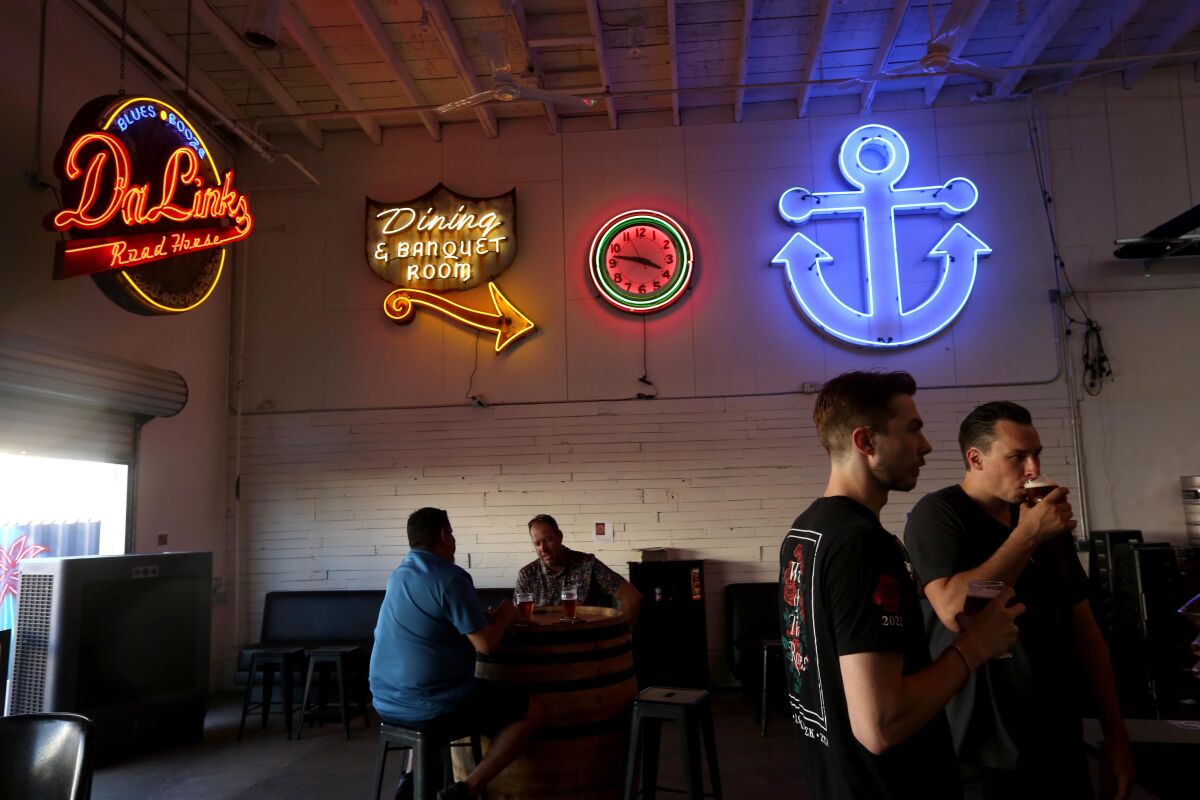
Inside the Neon Bear Brewery, which features neon works from the museum next door.
(Genaro Molina/Los Angeles Times)
The 20-minute tours will end at the brewery next door, Neon Bear, which houses works from the museum’s collection. The Wicked Kitchen food truck will be parked out front and Neon Bear will donate 20% of the day’s beer sales to MONA. The museum will also provide digital guides pointing visitors to other neon landmarks in the Pomona area.
“These inanimate objects are testaments to what we, as a society, can do and how it takes a community to steward history forward,” Siegel says. “They tell a very diverse story of Southern California.”
Siegel gave us the backstory behind several gems in the collection, with descriptions edited for clarity.
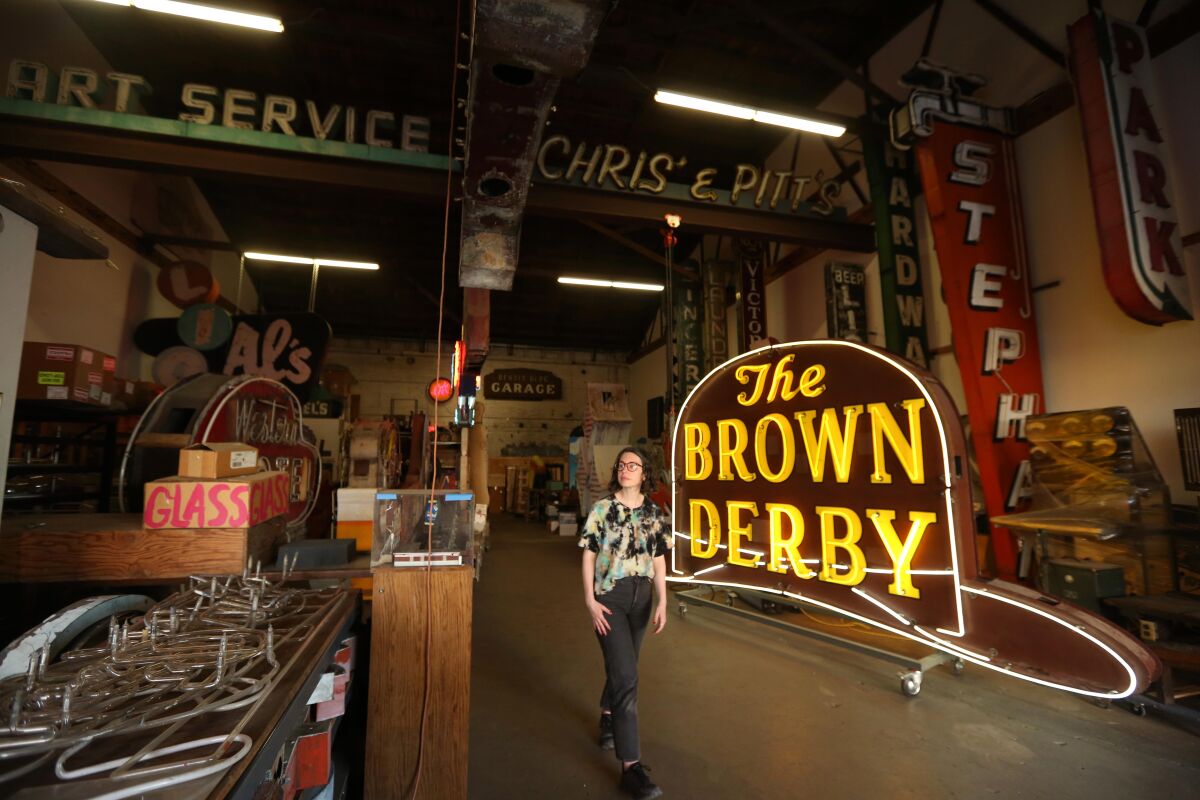
Corrie Siegel, executive director of the Museum of Neon Art, poses by the famed Brown Derby sign in the storage warehouse.
(Genaro Molina/Los Angeles Times)
The first thing you might want to know about the Brown Derby sign is that it’s corrugated sheet metal — called a ripple tin in the sign industry — that required double the amount of metal. It’s one of the ways you can tell a sign is pretty old. This is from 1929. You can’t find signs with ripple tin after World War II because there was a shortage of materials and it wasn’t worth using twice the amount of materials to make a sign.
The other thing is the Brown Derby was an iconic cultural force. The Hollywood Brown Derby is where we have a lot of celebrity stories, of people being there to see and be seen, my favorite being “I Love Lucy’s” Lucille Ball. One of the episodes was about Lucy and Ethel visiting the Brown Derby in this scheme to make encounters with celebrities. And it was a culinary influence. That’s where the Shirley Temple drink comes from, and the Cobb salad. The lore is that Sid Grauman — he started Grauman’s Chinese Theatre — went there after he’d had dental surgery and because of that the owner, Bob Cobb, chopped the salad up really fine for him.
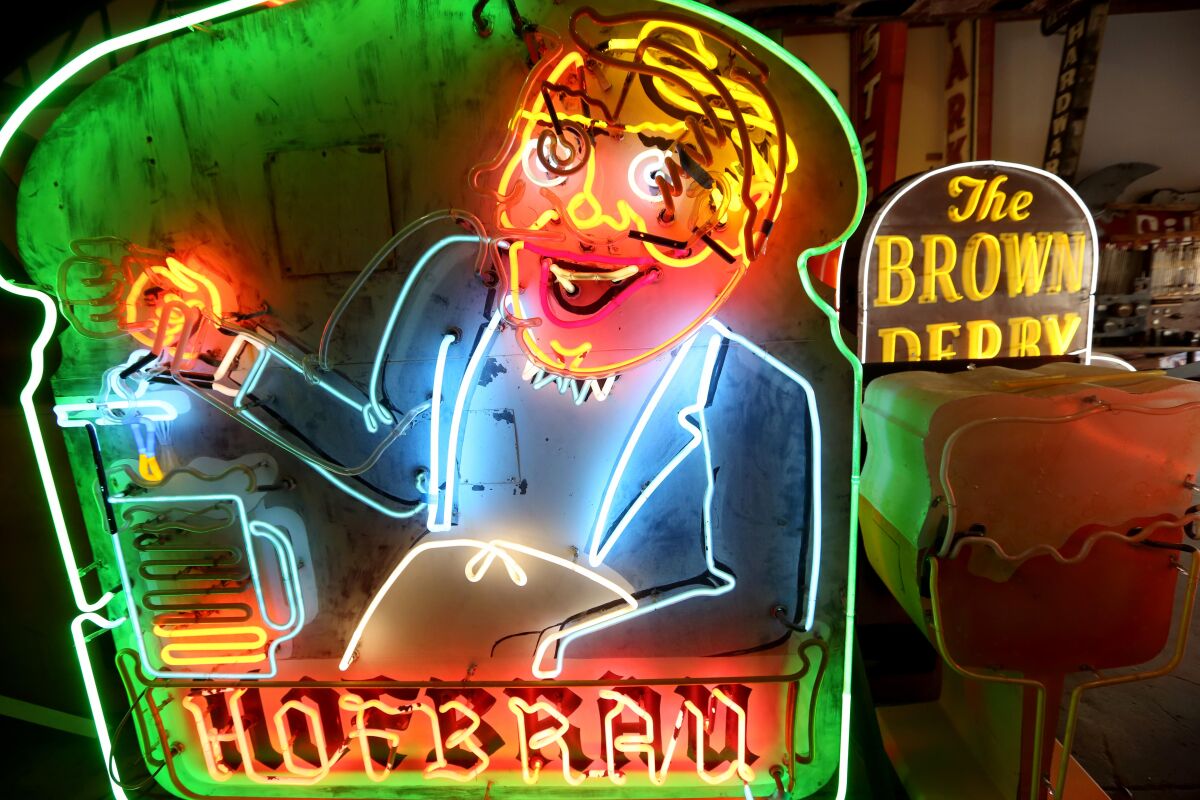
A neon sign from Oakland’s Hofbrau is animated.
(Genaro Molina/Los Angeles Times)
This sign comes from a bar in Oakland called the Hofbrau. The estimate is that it was made sometime between 1950 and ’59, but one of the interesting things about this sign is it used to be another sign. When we took it apart to wire it up, we found that inside the sign is housings for another sign. We haven’t figured out what that was yet, but we can tell there’s other gear in it and it’s probably from the 1920s or 1930s. It just goes to show these are cultural artifacts, they are things that have lived dynamic lives from business to business. The other component is it’s aesthetically interesting, it’s a very complex design. Because it’s intricately bent and layered glass and it’s animated. He fills his beer, it foams up and he turns his head to smile at the viewer.
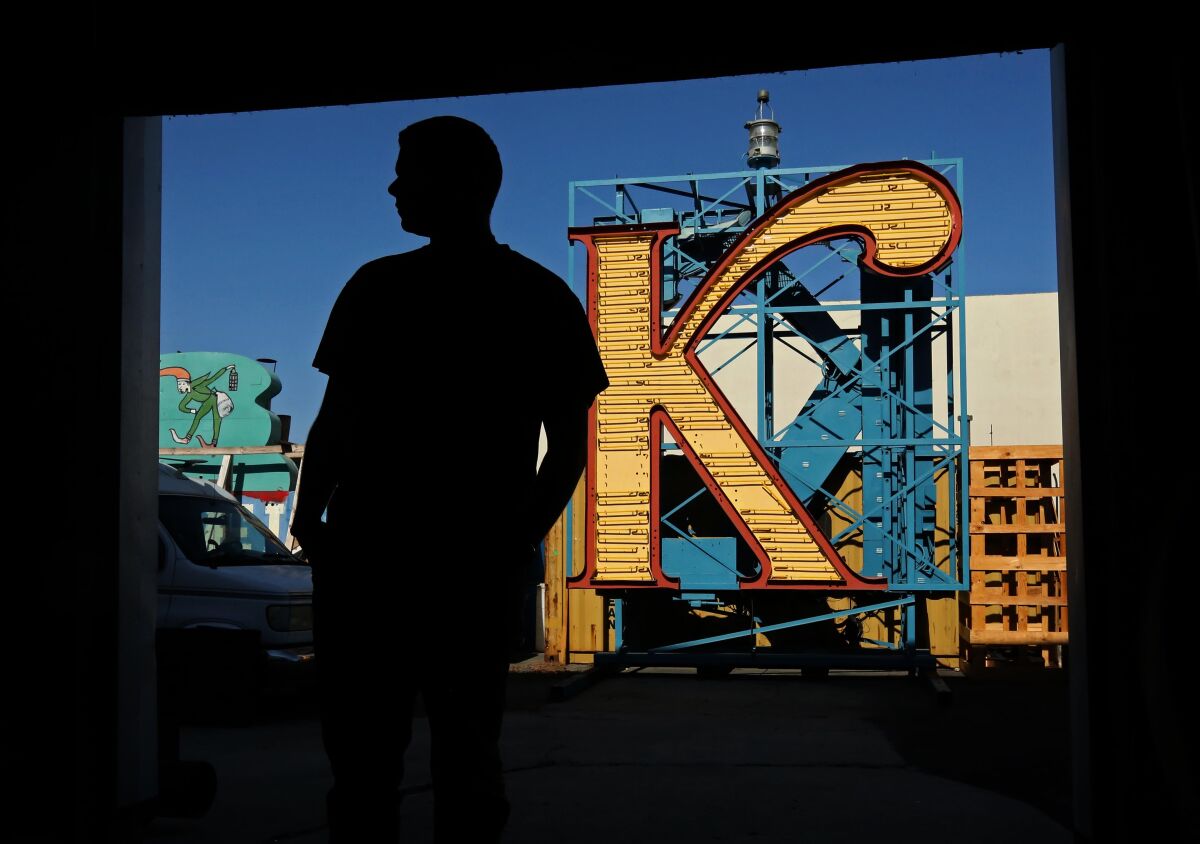
Will Raymond stands near the iconic “K” from the Knott’s Berry Farm sign.
(Genaro Molina/Los Angeles Times)
The Knott’s Berry K is a recent addition to our collection. It came to us in 2022; it was donated by Knott’s Berry Farm. It’s now 47 years old. They replaced the sign with a replica of it that’s all LEDs — some places believe LEDs are the future or better or they’re more versatile because they can change color and can be programmed. That’s something that faces neon — there are other, newer forms of technology out there. Also, in order to have a neon sign running, sometimes they need maintenance. It can be costly to maintain. But it creates a really distinct form of really warm bright light and it’s an over-100-year-old hand-rendered art form.
This particular sign is pretty iconic — it was visible from the 5 and 91 freeways. It’s very sentimental for people who went to Knott’s Berry Farm as kids. It’s a marker of a really significant, more than 100-year-old theme park that was one of the first in the U.S.
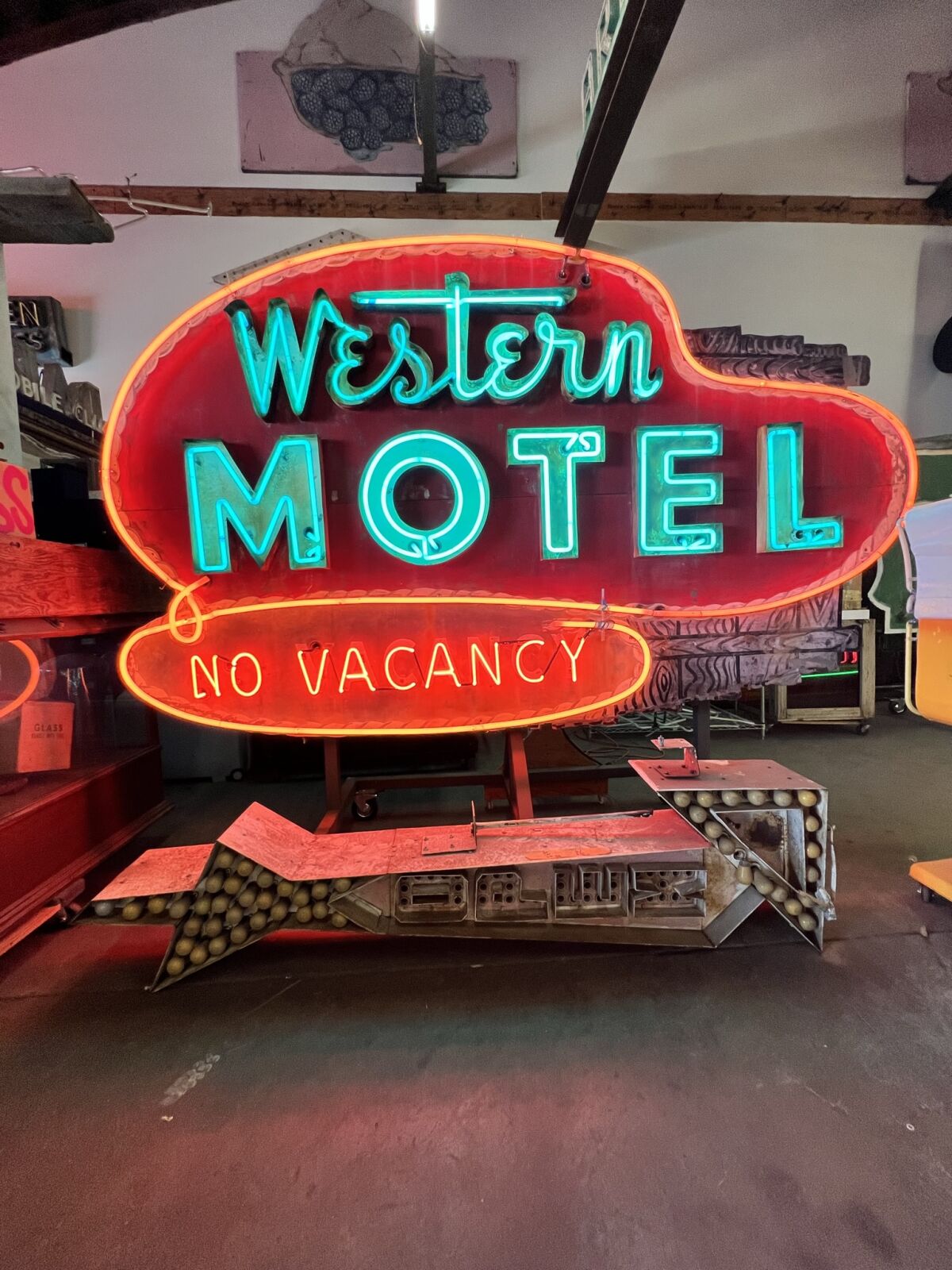
The Western Motel sign.
(Connie Conway via MONA)
The Western Motel is pretty notable. In terms of the aesthetic value and technical value, if you look at it, you’ll notice there’s different sizes of neon tubing. The thick neon tubing is very hard to bend. Also, this motel was in Venice, so you wouldn’t necessarily think lasso and cows and all that. But it just goes to show [the popularity of] this mythology of the wild west, despite it being on the beach. You’d think a beachy-themed motel would be more appropriate. But this became a very iconic way to market hotels in the American West in the 1950s. Standing for escapism and the iconography of the West. It’s just a really spectacular invitation — it’s metal painted to look like wood and the artist really spent time to craft this mythology on the sign.

Neon signage from a former Pep Boys, featuring Manny, Moe and Jack.
(Genaro Molina/Los Angeles Times)
This is Pep Boys. Manny, Moe and Jack. This is not something you would see at Pep Boys today because in 1990, Pep Boys changed their logo to remove Manny’s cigar. Their old-style signs were removed throughout L.A. It definitely marks a cultural shift, an interest in moving away from smoking to advertise automotive services. The sign itself is interesting for us to have in our collection. Part of the reason is because the script is in neon tubing. It’s channel letters which is meant to amplify the neon tubing. Also the faces of the boys, those are back-lit plastic signs with fluorescent bulbs inside of them — anyone could change it out. That was one of the things that kind of put neon artists out of business because you no longer needed skill to illuminate a sign.
This is from ‘70-’79. It’s a hybrid sign in that it has neon and back-lit plastic. Especially now, neon can coexist with many different types of signage. And we’re seeing this renaissance of neon art and signage now. Because, I think, people are more interested now in things that are made by hand. The retro aesthetic and the vintage aesthetic. It’s not either or — we live in this world where everything can coexist.
“Pomona Warehouse and Brewery Tour”
Where: 560 E. Commercial St., #21, Pomona
When: Sunday, July 9, 3-7 p.m. (Guided tours occur every 30 minutes. It’s recommended to buy tickets in advance. Check the site for future tours.)
Tickets: General admission for nonmembers: $30
Info: store.neonmona.org/products/pomona-warehouse-brewery-tour-7-9-2023
Stay connected with us on social media platform for instant update click here to join our Twitter, & Facebook
We are now on Telegram. Click here to join our channel (@TechiUpdate) and stay updated with the latest Technology headlines.
For all the latest Art-Culture News Click Here
